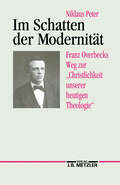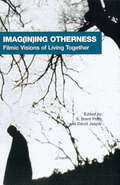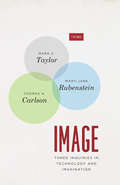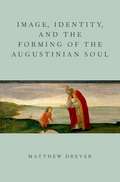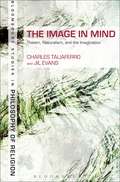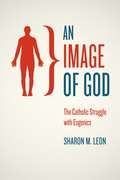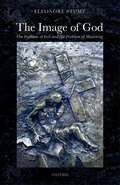- Table View
- List View
Im Schatten der Modernität: Franz Overbecks Weg zur "Christlichkeit unserer heutigen Theologie"
by Niklaus PeterAls "Zwillingspaar aus einem Haus" hat Nietzsche die 1873 fast gleichzeitig erschienen Schriften, seine Erste unzeitgemässe Betrachtung und die seines Freundes Franz Overbeck, "Über die Christlichkeit unserer heutigen Theologie", bezeichnet.
Imag: Filmic Visions of Living Together (AAR Cultural Criticism Series)
by S. Brent Plate David JasperImag(in)ing Otherness explores relationships between film and religion, aesthetics and ethics. The volume examines these relationships by viewing how otherness is imaged in film and how otherness alternately might be imagined. Drawing from a variety of films from differing religious perspectives--including Chan Buddhism, Hinduism, Native American religions, Christianity, and Judaism--the essays gathered in this volume examine the particular problems of "living together" when faced with the tensions brought out through the otherness of differing sexualities, ethnicities, genders, religions, cultures, and families.
Image: Three Inquiries in Technology and Imagination (TRIOS)
by Mark C. Taylor Mary-Jane Rubenstein Thomas A. CarlsonThe three essays in Image, written by leading philosophers of religion, explore the modern power of the visual at the intersection of the human and the technological. Modern life is steeped in images, image-making, and attempts to control the world through vision. Mastery of images has been advanced by technologies that expand and reshape vision and enable us to create, store, transmit, and display images. The three essays in Image, written by leading philosophers of religion Mark C. Taylor, Mary-Jane Rubenstein, and Thomas A. Carlson, explore the power of the visual at the intersection of the human and the technological. Building on Heidegger’s notion that modern humanity aims to master the world by picturing or representing the real, they investigate the contemporary culture of the image in its philosophical, religious, economic, political, imperial, and military dimensions, challenging the abstraction, anonymity, and dangerous disconnection of contemporary images. Taylor traces a history of capitalism, focusing on its lack of humility, particularly in the face of mortality, and he considers art as a possible way to reconnect us to the earth. Through a genealogy of iconic views from space, Rubenstein exposes the delusions of conquest associated with extraterrestrial travel. Starting with the pressing issues of surveillance capitalism and facial recognition technology, Carlson extends Heidegger’s analysis through a meditation on the telematic elimination of the individual brought about by totalizing technologies. Together, these essays call for a consideration of how we can act responsibly toward the past in a way that preserves the earth for future generations. Attending to the fragility of material things and to our own mortality, they propose new practices of imagination grounded in love and humility.
Image: Three Inquiries in Technology and Imagination (TRIOS)
by Mark C. Taylor Mary-Jane Rubenstein Thomas A. CarlsonThe three essays in Image, written by leading philosophers of religion, explore the modern power of the visual at the intersection of the human and the technological. Modern life is steeped in images, image-making, and attempts to control the world through vision. Mastery of images has been advanced by technologies that expand and reshape vision and enable us to create, store, transmit, and display images. The three essays in Image, written by leading philosophers of religion Mark C. Taylor, Mary-Jane Rubenstein, and Thomas A. Carlson, explore the power of the visual at the intersection of the human and the technological. Building on Heidegger’s notion that modern humanity aims to master the world by picturing or representing the real, they investigate the contemporary culture of the image in its philosophical, religious, economic, political, imperial, and military dimensions, challenging the abstraction, anonymity, and dangerous disconnection of contemporary images. Taylor traces a history of capitalism, focusing on its lack of humility, particularly in the face of mortality, and he considers art as a possible way to reconnect us to the earth. Through a genealogy of iconic views from space, Rubenstein exposes the delusions of conquest associated with extraterrestrial travel. Starting with the pressing issues of surveillance capitalism and facial recognition technology, Carlson extends Heidegger’s analysis through a meditation on the telematic elimination of the individual brought about by totalizing technologies. Together, these essays call for a consideration of how we can act responsibly toward the past in a way that preserves the earth for future generations. Attending to the fragility of material things and to our own mortality, they propose new practices of imagination grounded in love and humility.
Image and Glory of God: 1 Corinthians 11:2-16 As A Case Study In Bible, Gender And Hermeneutics (The Library of New Testament Studies #418)
by Michael LakeyThis hermeneutical case-study illustrates the complexities of using biblical materials to shed light upon present-day concerns. The specific situation addressed is the recent evangelical controversy regarding gender roles. A significant strand of this debate concerns the relationship between gender and the doctrine of God. This proposition is derived from 1 Corinthians 11. Whilst aspects of this argument are criticized, Lakey also argues that questions of God and gender are related. 1 Corinthians 11:2-16 articulates sexual difference using the metaphysical language of antiquity, thereby situating the sexes vis-Á -vis each other as microcosms of God and Christ vis-Á -vis the cosmos. For Paul, the Church circumscribes that part of the cosmos able to express its creaturely relationship to God.However, modern interpreters arguably cannot share Paul's cosmological and anthropological assumptions. Lakey points us towards forging a solution for how to interpret as Christian Scripture a text that invites its readers to assume a stance that is now problematic for many modern Christians.
Image and Presence: A Christological Reflection on Iconoclasm and Iconophilia (Encountering Traditions)
by Natalie CarnesImages increasingly saturate our world, making present to us what is distant or obscure. Yet the power of images also arises from what they do not make present—from a type of absence they do not dispel. Joining a growing multidisciplinary conversation that rejects an understanding of images as lifeless objects, this book offers a theological meditation on the ways images convey presence into our world. Just as Christ negates himself in order to manifest the invisible God, images, Natalie Carnes contends, negate themselves to give more than they literally or materially are. Her Christological reflections bring iconoclasm and iconophilia into productive relation, suggesting that they need not oppose one another. Investigating such images as the biblical golden calf and paintings of the Virgin Mary, Carnes explores how to distinguish between iconoclasms that maintain fidelity to their theological intentions and those that lead to visual temptation. Offering ecumenical reflections on issues that have long divided Protestant, Catholic, and Orthodox traditions, Image and Presence provokes a fundamental reconsideration of images and of the global image crises of our time.
Image and Reality: The Jews in the World of the Christians in the Second Century
by Judith LieuJudith Lieu examines the rhetorical function of Jews in the early texts of the second century and seeks to acknowledge the complex nature of an issue which is too easily proclaimed 'Christian anti-Semitism'.
Image Bearers: Restoring our identity and living out our calling
by Rachel Atkinson Michael LloydRestoration is one of the basic building-blocks to Christian growth: it affects the way we relate to God, to ourselves, and to others. When we allow God to restore us, shape us and refine us into the people we were made to be, we can enjoy His presence more fully, live more freely, and reflect His image more closely.Drawing on the work of a close friend and counsellor, Ruth Miller, who died in 2013, Image Bearers has been inspired by Ruth's significant ministry of individual counselling and pastoral healing. Beginning with a theological framework for restoration, each chapter builds on the brokenness we experience in life - our anxieties, fear and failures - and equips us with spiritual practices to improve our prayer, evangelism and pastoral care, giving us a greater vision for God's restoration in our own lives. Image Bearers is written for anyone wishing to grow into greater Christian maturity. In this joint venture, Rachel Atkinson and Michael Lloyd encourage us to live lives that are theologically grounded and practically applied; restoration cannot simply be taught but must be experienced, lived and modelled.
Image, Identity and John Wesley: A Study in Portraiture (Routledge Methodist Studies Series)
by Peter S. ForsaithThe face of John Wesley (1703–91), the Methodist leader, became one of the most familiar images in the English-speaking and transatlantic worlds through the late eighteenth and nineteenth centuries. After the dozen or so painted portraits made during his lifetime came numbers of posthumous portraits and moralising ‘scene paintings’, and hundreds of variations of prints. It was calculated that six million copies were produced of one print alone – an 1827 portrait by John Jackson R.A. as frontispiece for a hymn book. Illustrated by nearly one hundred images, many in colour, with a comprehensive appendix listing known Wesley images, this book offers a much-needed comprehensive and critical survey of one of the most influential religious and public figures of eighteenth-century Britain. Besides chapters on portraits from the life and after, scene paintings and prints, it explores aspects of Wesley’s (and Methodism’s) attitudes to art, and the personality cult which gathered around Wesley as Methodism expanded globally. It will be of interest to art historians as a treatment of an individual sitter and subject, as well as to scholars engaged in Wesley and Methodist studies. It is also significant for the field of material studies, given the spread and use of the image, on artefacts as well as on paper.
Image, Identity and John Wesley: A Study in Portraiture (Routledge Methodist Studies Series)
by Peter S. ForsaithThe face of John Wesley (1703–91), the Methodist leader, became one of the most familiar images in the English-speaking and transatlantic worlds through the late eighteenth and nineteenth centuries. After the dozen or so painted portraits made during his lifetime came numbers of posthumous portraits and moralising ‘scene paintings’, and hundreds of variations of prints. It was calculated that six million copies were produced of one print alone – an 1827 portrait by John Jackson R.A. as frontispiece for a hymn book. Illustrated by nearly one hundred images, many in colour, with a comprehensive appendix listing known Wesley images, this book offers a much-needed comprehensive and critical survey of one of the most influential religious and public figures of eighteenth-century Britain. Besides chapters on portraits from the life and after, scene paintings and prints, it explores aspects of Wesley’s (and Methodism’s) attitudes to art, and the personality cult which gathered around Wesley as Methodism expanded globally. It will be of interest to art historians as a treatment of an individual sitter and subject, as well as to scholars engaged in Wesley and Methodist studies. It is also significant for the field of material studies, given the spread and use of the image, on artefacts as well as on paper.
Image, Identity, and the Forming of the Augustinian Soul (AAR Academy Series)
by Matthew DreverIn our current pluralist context, there is no clearly designated means of valuing or defining the human person. Matthew Drever shows that in the writings of St. Augustine we find a concept of the human person that is fluid, tenuous, prone to great good and great vice, and influenced deeply by the wider spiritual and material environment. Through an examination of his account of the human relation to God, Drever demonstrates how Augustine can offer a crucial resource for a religious reorientation and revaluation of the human person. Drever focuses particularly on the concepts of the imago dei and creatio ex nihilo, significant for their influence on Augustine's understanding of the human person and for their potential to bridge his and our own world. Though rooted in Augustine's early work, these concepts are developed fully in his later writings: his Genesis commentaries and On the Trinity in particular. Drever examines how in these later writings the origin (creatio ex nihilo) and identity (imago dei) of the human person intersect with Augustine's understanding of creation, Christ, and the Trinity. Image, Identity, and the Forming of the Augustinian Soul constructs an interpretation of Augustine's view of the person that acknowledges its classical context while also addressing contemporary theological and philosophical appropriations of Augustine and the issues that animate them.
The Image in Mind: Theism, Naturalism, and the Imagination (Continuum Studies in Philosophy of Religion)
by Charles Taliaferro Jil EvansA philosophical inquiry into the strengths and weaknesses of theism and naturalism in accounting for the emergence of consciousness, the visual imagination and aesthetic values. The authors begin by offering an account of modern scientific practice which gives a central place to the visual imagination and aesthetic values. They then move to test the explanatory power of naturalism and theism in accounting for consciousness and the very visual imagination and aesthetic values that lie behind and define modern science. Taliaferro and Evans argue that evolutionary biology alone is insufficient to account for consciousness, the visual imagination and aesthetic values. Insofar as naturalism is compelled to go beyond evolutionary biology, it does not fare as well as theism in terms of explanatory power.
The Image in Mind: Theism, Naturalism, and the Imagination (Bloomsbury Studies in Philosophy of Religion)
by Charles Taliaferro Jil EvansA philosophical inquiry into the strengths and weaknesses of theism and naturalism in accounting for the emergence of consciousness, the visual imagination and aesthetic values. The authors begin by offering an account of modern scientific practice which gives a central place to the visual imagination and aesthetic values. They then move to test the explanatory power of naturalism and theism in accounting for consciousness and the very visual imagination and aesthetic values that lie behind and define modern science. Taliaferro and Evans argue that evolutionary biology alone is insufficient to account for consciousness, the visual imagination and aesthetic values. Insofar as naturalism is compelled to go beyond evolutionary biology, it does not fare as well as theism in terms of explanatory power.
The Image of Christ in Modern Art
by Richard HarriesThe Image of Christ in Modern Art explores the challenges presented by the radical and rapid changes of artistic style in the 20th century to artists who wished to relate to traditional Christian imagery. In the 1930s David Jones said that he and his contemporaries were acutely conscious of ’the break’, by which he meant the fragmentation and loss of a once widely shared Christian narrative and set of images. In this highly illustrated book, Richard Harries looks at some of the artists associated with the birth of modernism such as Epstein and Rouault as well as those with a highly distinctive understanding of religion such as Chagall and Stanley Spencer. He discusses the revival of confidence associated with the rebuilding of Coventry Cathedral after World War II and the commissioning of work by artists like Henry Moore, Graham Sutherland and John Piper before looking at the very testing last quarter of the 20th century. He shows how here, and even more in our own time, fresh and important visual interpretations of Christ have been created both by well known and less well known artists. In conclusion he suggests that the modern movement in art has turned out to be a friend, not a foe of Christian art.Through a wide and beautiful range of images and insightful text, Harries explores the continuing challenge, present from the beginning of Christian art, as to how that which is visual can in some way indicate the transcendent.
The Image of Christ in Modern Art
by Richard HarriesThe Image of Christ in Modern Art explores the challenges presented by the radical and rapid changes of artistic style in the 20th century to artists who wished to relate to traditional Christian imagery. In the 1930s David Jones said that he and his contemporaries were acutely conscious of ’the break’, by which he meant the fragmentation and loss of a once widely shared Christian narrative and set of images. In this highly illustrated book, Richard Harries looks at some of the artists associated with the birth of modernism such as Epstein and Rouault as well as those with a highly distinctive understanding of religion such as Chagall and Stanley Spencer. He discusses the revival of confidence associated with the rebuilding of Coventry Cathedral after World War II and the commissioning of work by artists like Henry Moore, Graham Sutherland and John Piper before looking at the very testing last quarter of the 20th century. He shows how here, and even more in our own time, fresh and important visual interpretations of Christ have been created both by well known and less well known artists. In conclusion he suggests that the modern movement in art has turned out to be a friend, not a foe of Christian art.Through a wide and beautiful range of images and insightful text, Harries explores the continuing challenge, present from the beginning of Christian art, as to how that which is visual can in some way indicate the transcendent.
The Image of Christ in Russian Literature: Dostoevsky, Tolstoy, Bulgakov, Pasternak (NIU Series in Orthodox Christian Studies)
by John GivensVladimir Nabokov complained about the number of Dostoevsky's characters "sinning their way to Jesus." In truth, Christ is an elusive figure not only in Dostoevsky's novels, but in Russian literature as a whole. The rise of the historical critical method of biblical criticism in the nineteenth century and the growth of secularism it stimulated made an earnest affirmation of Jesus in literature highly problematic. If they affirmed Jesus too directly, writers paradoxically risked diminishing him, either by deploying faith explanations that no longer persuade in an age of skepticism or by reducing Christ to a mere argument in an ideological dispute. The writers at the heart of this study understood that to reimage Christ for their age, they had to make him known through indirect, even negative ways, lest what they say about him be mistaken for cliché, doctrine, or naïve apologetics. The Christology of Dostoevsky, Leo Tolstoy, Mikhail Bulgakov, and Boris Pasternak is thus apophatic because they deploy negative formulations (saying what God is not) in their writings about Jesus. Professions of atheism in Dostoevsky and Tolstoy's non-divine Jesus are but separate negative paths toward truer discernment of Christ. This first study in English of the image of Christ in Russian literature highlights the importance of apophaticism as a theological practice and a literary method in understanding the Russian Christ. It also emphasizes the importance of skepticism in Russian literary attitudes toward Jesus on the part of writers whose private crucibles of doubt produced some of the most provocative and enduring images of Christ in world literature. This important study will appeal to scholars and students of Orthodox Christianity and Russian literature, as well as educated general readers interested in religion and nineteenth-century Russian novels.
An Image of God: The Catholic Struggle with Eugenics
by Sharon M. LeonDuring the first half of the twentieth century, supporters of the eugenics movement offered an image of a racially transformed America by curtailing the reproduction of “unfit” members of society. Through institutionalization, compulsory sterilization, the restriction of immigration and marriages, and other methods, eugenicists promised to improve the population—a policy agenda that was embraced by many leading intellectuals and public figures. But Catholic activists and thinkers across the United States opposed many of these measures, asserting that “every man, even a lunatic, is an image of God, not a mere animal." In An Image of God, Sharon Leon examines the efforts of American Catholics to thwart eugenic policies, illuminating the ways in which Catholic thought transformed the public conversation about individual rights, the role of the state, and the intersections of race, community, and family. Through an examination of the broader questions raised in this debate, Leon casts new light on major issues that remain central in American political life today: the institution of marriage, the role of government, and the separation of church and state. This is essential reading in the history of religion, science, politics, and human rights.
An Image of God: The Catholic Struggle with Eugenics
by Sharon M. LeonDuring the first half of the twentieth century, supporters of the eugenics movement offered an image of a racially transformed America by curtailing the reproduction of “unfit” members of society. Through institutionalization, compulsory sterilization, the restriction of immigration and marriages, and other methods, eugenicists promised to improve the population—a policy agenda that was embraced by many leading intellectuals and public figures. But Catholic activists and thinkers across the United States opposed many of these measures, asserting that “every man, even a lunatic, is an image of God, not a mere animal." In An Image of God, Sharon Leon examines the efforts of American Catholics to thwart eugenic policies, illuminating the ways in which Catholic thought transformed the public conversation about individual rights, the role of the state, and the intersections of race, community, and family. Through an examination of the broader questions raised in this debate, Leon casts new light on major issues that remain central in American political life today: the institution of marriage, the role of government, and the separation of church and state. This is essential reading in the history of religion, science, politics, and human rights.
An Image of God: The Catholic Struggle with Eugenics
by Sharon M. LeonDuring the first half of the twentieth century, supporters of the eugenics movement offered an image of a racially transformed America by curtailing the reproduction of “unfit” members of society. Through institutionalization, compulsory sterilization, the restriction of immigration and marriages, and other methods, eugenicists promised to improve the population—a policy agenda that was embraced by many leading intellectuals and public figures. But Catholic activists and thinkers across the United States opposed many of these measures, asserting that “every man, even a lunatic, is an image of God, not a mere animal." In An Image of God, Sharon Leon examines the efforts of American Catholics to thwart eugenic policies, illuminating the ways in which Catholic thought transformed the public conversation about individual rights, the role of the state, and the intersections of race, community, and family. Through an examination of the broader questions raised in this debate, Leon casts new light on major issues that remain central in American political life today: the institution of marriage, the role of government, and the separation of church and state. This is essential reading in the history of religion, science, politics, and human rights.
An Image of God: The Catholic Struggle with Eugenics
by Sharon M. LeonDuring the first half of the twentieth century, supporters of the eugenics movement offered an image of a racially transformed America by curtailing the reproduction of “unfit” members of society. Through institutionalization, compulsory sterilization, the restriction of immigration and marriages, and other methods, eugenicists promised to improve the population—a policy agenda that was embraced by many leading intellectuals and public figures. But Catholic activists and thinkers across the United States opposed many of these measures, asserting that “every man, even a lunatic, is an image of God, not a mere animal." In An Image of God, Sharon Leon examines the efforts of American Catholics to thwart eugenic policies, illuminating the ways in which Catholic thought transformed the public conversation about individual rights, the role of the state, and the intersections of race, community, and family. Through an examination of the broader questions raised in this debate, Leon casts new light on major issues that remain central in American political life today: the institution of marriage, the role of government, and the separation of church and state. This is essential reading in the history of religion, science, politics, and human rights.
The Image of God: The Problem of Evil and the Problem of Mourning
by Eleonore StumpThe problem of evil has generated varying attempts at theodicy. To show that suffering is defeated for a sufferer, a theodicy argues that there is an outweighing benefit which could not have been gotten without the suffering. Typically, this condition has the tacit presupposition given that this is a post-Fall world. Consequently, there is a sense in which human suffering would not be shown to be defeated even if there were a successful theodicy because a theodicy typically implies that the benefit in question could have been gotten without the suffering if there had not been a Fall. There is a part of the problem of evil that would remain, then, even if there were a successful theodicy. This is the problem of mourning: even defeated suffering in the post-Fall world merits mourning. How is this warranted mourning compatible with the existence of an omniscient, omnipotent, perfectly good God? The traditional response to this problem is the felix culpa view, which maintains that the original sin was fortunate because there is an outweighing benefit to sufferers that could not be gotten in a world without suffering. The felix culpa view presupposes an object of evaluation, namely, the true self of a human being, and a standard of evaluation for human lives. This book explores these and a variety of other topics in philosophical theology in order to explain and evaluate the role of suffering in human lives.
The Image of God: The Problem of Evil and the Problem of Mourning
by Eleonore StumpThe problem of evil has generated varying attempts at theodicy. To show that suffering is defeated for a sufferer, a theodicy argues that there is an outweighing benefit which could not have been gotten without the suffering. Typically, this condition has the tacit presupposition given that this is a post-Fall world. Consequently, there is a sense in which human suffering would not be shown to be defeated even if there were a successful theodicy because a theodicy typically implies that the benefit in question could have been gotten without the suffering if there had not been a Fall. There is a part of the problem of evil that would remain, then, even if there were a successful theodicy. This is the problem of mourning: even defeated suffering in the post-Fall world merits mourning. How is this warranted mourning compatible with the existence of an omniscient, omnipotent, perfectly good God? The traditional response to this problem is the felix culpa view, which maintains that the original sin was fortunate because there is an outweighing benefit to sufferers that could not be gotten in a world without suffering. The felix culpa view presupposes an object of evaluation, namely, the true self of a human being, and a standard of evaluation for human lives. This book explores these and a variety of other topics in philosophical theology in order to explain and evaluate the role of suffering in human lives.
The Image of God and the Psychology of Religion
by Richard L Dayringer David OlerWhat are the implications of a client&’s image of God?Improve your confidence-and your practice skills-by enhancing your knowledge of how individuals are likely to perceive God, and of how those perceptions impact the way they function as human beings. Theologians have long speculated and theorized about how humans imagine God to be. This book merges theology with science, presenting empirical research focused on perceptions of God in a variety of populations living in community and mental health settings. Each chapter concludes with references that comprise an essential reading list, and the book is generously enhanced with tables that make data easy to access and understand. "Liberating Images of God" discusses the constriction and impoverishment of God images due to the traditional restrictions of God images to those that are male and personified. This chapter examines the potential for the client and counselor&’s co-creation of images of God which embrace the feminine as well as the masculine, the nurturer as well as the warrior, and the natural world in all its dimensions as well as the human world, to liberate, enrich, sustain, and transform the client&’s relationships with God and with him/herself. "Attachment, Well-Being, and Religious Participation Among People with Severe Mental Disorders" examines the relationship between attachment states of mind and religious participation among people diagnosed with severe mental illness. "Concepts of God and Therapeutic Alliance Among People with Severe Mental Disorders" explores the transferential aspects of God representation among severely mentally ill adults. It highlights research on the relationship between a patient&’s image of God and that patient&’s working relationship with his/her case manager, and discusses the implications for clinical practice of those findings. "The Subjective Experience of God" presents a theory about the psychological basis for the experience of God that argues that this experience is essentially a form of projection and as such is an internal event that does not exist independent of an individual&’s psyche. This chapter draws a distinction between faith in a particular belief-namely, faith in the existence of a loving, omnipotent God-and an attitude of faith, which is the basis for experiences of transcendence. "Relationship of Gender Role Identity and Attitudes" presents the results of a study in which nearly 300 Catholic attendees at three university Catholic centers completed the Bern Sex Role Inventory, the Attitudes Toward Women Scale, and the Perceptions of God Checklist. This chapter looks at images of God as masculine or feminine, and at the connection for people between the way they perceive God and the way they relate towards men and women. "Reflections on a Study in a Mental Hospital," brings you groundbreaking new research on perceptions of God in an inpatient population. This chapter examines the positive effects (as opposed to the negative effects previously portrayed by the psychological community) of religious belief and practice for residential care patients in a psychiatric hospital.
The Image of God and the Psychology of Religion
by Richard L Dayringer David OlerWhat are the implications of a client&’s image of God?Improve your confidence-and your practice skills-by enhancing your knowledge of how individuals are likely to perceive God, and of how those perceptions impact the way they function as human beings. Theologians have long speculated and theorized about how humans imagine God to be. This book merges theology with science, presenting empirical research focused on perceptions of God in a variety of populations living in community and mental health settings. Each chapter concludes with references that comprise an essential reading list, and the book is generously enhanced with tables that make data easy to access and understand. "Liberating Images of God" discusses the constriction and impoverishment of God images due to the traditional restrictions of God images to those that are male and personified. This chapter examines the potential for the client and counselor&’s co-creation of images of God which embrace the feminine as well as the masculine, the nurturer as well as the warrior, and the natural world in all its dimensions as well as the human world, to liberate, enrich, sustain, and transform the client&’s relationships with God and with him/herself. "Attachment, Well-Being, and Religious Participation Among People with Severe Mental Disorders" examines the relationship between attachment states of mind and religious participation among people diagnosed with severe mental illness. "Concepts of God and Therapeutic Alliance Among People with Severe Mental Disorders" explores the transferential aspects of God representation among severely mentally ill adults. It highlights research on the relationship between a patient&’s image of God and that patient&’s working relationship with his/her case manager, and discusses the implications for clinical practice of those findings. "The Subjective Experience of God" presents a theory about the psychological basis for the experience of God that argues that this experience is essentially a form of projection and as such is an internal event that does not exist independent of an individual&’s psyche. This chapter draws a distinction between faith in a particular belief-namely, faith in the existence of a loving, omnipotent God-and an attitude of faith, which is the basis for experiences of transcendence. "Relationship of Gender Role Identity and Attitudes" presents the results of a study in which nearly 300 Catholic attendees at three university Catholic centers completed the Bern Sex Role Inventory, the Attitudes Toward Women Scale, and the Perceptions of God Checklist. This chapter looks at images of God as masculine or feminine, and at the connection for people between the way they perceive God and the way they relate towards men and women. "Reflections on a Study in a Mental Hospital," brings you groundbreaking new research on perceptions of God in an inpatient population. This chapter examines the positive effects (as opposed to the negative effects previously portrayed by the psychological community) of religious belief and practice for residential care patients in a psychiatric hospital.
